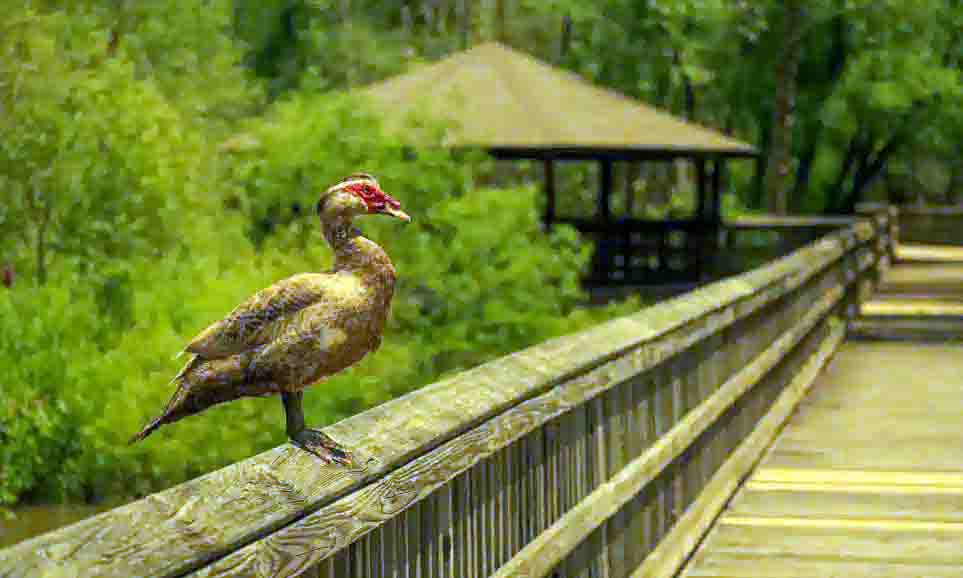Muscovy Ducks Guide
When thinking of nuisance birds, people usually the first species that people think of are geese and pigeons. In general, ducks on not high on this list, except for Muscovy ducks. Originally, Muscovy ducks were food animals. They are native to Texas and South America but also thrive in Florida. It is easy to recognize Muscovy ducks by the red, irregular skin on their faces. These birds are considered to be invasive since they are found in areas outside of their home state. Invasive animals such as Muscovy ducks take habitats over and may stress natural ecosystems and destroy animals and native plants. The Muscovy duck is the biggest duck species. They hiss instead of quack since they do not have any vocal cords.
What Are Muscovy Ducks?
This species of duck is native to tropical climates. However, they can adapt as well to colder temperatures. In parts of the U.S., they were introduced purposely as non-native species in order to improve the aesthetics of lakes and public parks. They are among the world’s oldest fowl species, and it is thought that “muscovy’ references the Muscovy Company, which was the firm that transported the ducks.
Although it does appear that Muscovy can peacefully coexist with native species, scientists are concerned about interbreeding since it is not known whether or not the offspring of inter-species mating will be able to adapt, endure, and withstand disease.
In addition to looking pretty, Muscovy ducks might help humans since they feed on harmful and annoying insects, like termites. Muscovy ducks in Florida have overtaken numerous ponds and parks.
What Does a Muscovy Duck Look Like
A Muscovy Duck is a heavy-bodied, long-neck duck that can make it appear to look like a small goose. Its bill is fairly long and slopes up smoothly to the forehead. It has a fairly long tail as well. Males are bigger than females. Domesticated Muscovy ducks are bigger than wild ducks as well. The Muscovy is a large duck, and its wingspan can be as much as 64 inches. It can weigh up to 15 pounds and is a heavy type of duck, although the females are closers to 6-7 pounds and so are lighter.
Since the male ducks are so heavy, it can be a struggle for them to fly. However, the females can fly, and their wings call need to be clipped if you don’t want them to leave.
The ducks have flat, wide tails and long broad bodies (males are about 30 inches). Usually, their colors are white and black. However, there are many variations as well, including rippled, disallowed, bronze, lavender, white, green pied (white with another color), chocolate, black, and blue.
What Colors Are Muscovy Ducks?
Most Muscovy Ducks are the color black. Adult males have broad white patches on their wings, while juveniles have much smaller patches of white on their wings. In good light, the black feathers display a greenish gloss. Feral and domesticated Muscovy Ducks might have big white spots, which vary from brown to white patches.
The Muscovy Duck’s initial color is a glossy black/brown and white. Most of them remain that color – and have varying degrees of brown, black, or white (pieds). Some are a very light color (mostly white). Others are mainly black or brown. The dark brown/black patches have an iridescence which is appealing that is only seen in ideal light conditions.
There have also been many other very exotic colors – mainly in domestic types of ducks. They include calico, lavender, white and chocolate, chocolate, blue and white, and blue.
Dark-colored Muscovy ducks have brown eyes, while usually blues, lilacs, and whites have grey eyes.
What Do Muscovy Ducks Eat?
Like most ducks, Muscovy Ducks eat a combination of small animals and plants. They tend to search for food close to the water’s edge or in the water. Some of the plants that they eat include marine vegetation, roots, seeds, and lawn.
In addition, they hunt for lizards, fish, snails, worms, shrimp, spiders, and small bugs. Birds in metropolitan areas like golf courses and parks also eat many other types of foods. Usually, they are things that humans deliberately feed them or leave behind.
How Do Muscovy Ducks Reproduce?
Each year, a Muscovy Duck lays 60 to 120 big white eggs (low for ducks).
Females reach their sexual maturity in 28 weeks, while males reach it in 29 weeks. The Muscovy duck’s mating season can last from August through May. It can vary by climate. As long as females have a sufficient amount of protein in their diets, they can have 3 or 4 broods per year.
Muscovy Ducks do not have a courtship routine other than putting the head crest up and plenty of tail wagging. Males have been known to eliminate one another for chances to mate with the female ducks.
These ducks are polygamous. However, males may help to protect the ducklings and nest.
Female Muscovy Ducks set their nests inside a tree’s big cavity or in a ready-made next box that is suitably secure and off of the ground or inside an elevated duck house. Muscovy ducks do not like duck houses that sit on the ground.
Habitat
The Muscovy duck is a quick and agile bird. It is active throughout the entire day and is non-migratory. Typically the birds will roost in trees during the night.
Muscovy Ducks spend their days feeding by meddling shallow water or grazing the ground. They are social birds and tend to be seen in small groups or sets.
These ducks are aggressive. Males tend to fight over mates, area, or food. Females fight with one another less frequently. Some adult ducks peck at ducklings when they are trying to eat from the same source of food.
To communicate with one another, Muscovy ducks use various vocalizations comprised of quacks and hisses, lower and raise their heads, and wag their tails. Females have a peaceful trilling cool, while males produce low, breathy calls.
Muscovy Duck Dangers
When Muscovy Ducks are present in public parks, this can be dangerous for humans since their populations expand very quickly and rapidly, and they become territorial. The ducks will chase people and try to bite them at random. This can be especially dangerous to children, especially after they become used to being fed.
Also, many health risks are faced by Muscovies. Their droppings may get into sources of water for one thing, and this can have a significant impact. Muscovy ducks are also known to be avian influenza virus carriers. This can be lethal for humans as well as ducks who suffer from this disease.
Trapping And Removing Muscovy Ducks
Like most other aquatic birds, Muscovy ducks will make their homes in your yard. The problem with this is the ducks will fill your yard with excrement or ruin it, depending on how many ducks there are. Not knowing what you should do can result in many expenses when trying to repair your yard.
If you don’t have any experience, you should not try to use traps with Muscovy ducks. The size and number of birds make it nearly impossible for normal traps to be used to get rid of the ducks. Large funnel traps are needed to capture the whole party. It is also a very bad idea to shoot them, especially when you are unfamiliar with your area’s bird shooting laws. If you need help with removing Muscovy Ducks off of your property, give Affordable Wildlife Removal a call so they can solve your duck problem quickly.
Summary: The Muscovy duck is a type of bid that is native to tropical climates. They tend to be black and also have white spots. You can find them near parks, ponds, and other places, food/water sources, and open grass. Muscovy ducks may become aggressive and, even if unprovoked, may bite people. It can be hard to achieve removal since these ducks fly in a pack. Your best option is to hire a professional wildlife service to ensure these ducks are completely eliminated from your property. There are many people who try to handle a Muscovy duck problem on their own but many times end up making things worse.
Removing Muscovy Ducks
In Florida, Muscovy Ducks are becoming increasingly common. They can significantly damage your property and be a safety hazard as well since they can carry and spread avian diseases.
People have tried to control Muscovy ducks by hunting them. However, this has been shown to be ineffective at keeping the duck populations under control. In many areas of Florida, it is illegal to trap them, so the only solution left is to try to use netting. There are many different ways to go about this, so it is essential to research which method will work the best for your individual situation before committing to anything.
The Top 10 Facts That You Need To Know About Muscovy Ducks
- – Muscovy ducks are intelligent. You can train them to do tasks around your house and care for themselves.
- – They are one of the world’s best-selling breeds of ducks. Every year, more than one million are sold.
- – The average weight of mature males is 9 to 14 pounds, while mature females average 7 to 10 pounds.
- – Muscovy ducks are well-known for being hardy and being able to adapt to all different types of climates.
- – For each clutch, females lay 30 to 60 eggs. During breeding season (March to September), males mate with as many as ten females.
- – Muscovy drakes, unlike most breeds, do not contribute to the incubation of the eggs or help to raise the young (they spend their time mating instead).
- – The birds have a strange quack that sounds similar to an old car horn.
- – Muscovy Ducks often get on top of properties and spread their feces all over.
- -There is a big nuisance wildlife problem in Orlando, especially with Muscovy Ducks.
- – It is well-known that male Muscovy Ducks will attack neighborhood pets.

